Master Essential Commands: Effective Dog Educating Made Easy
Efficient canine training is a fundamental aspect of liable pet dog possession, and understanding necessary commands works as the structure for an unified connection between handler and dog. Commands such as "Sit," "Keep," and "Come" not just assist in interaction yet likewise promote a safer atmosphere. Employing positive support strategies can enhance the knowing experience, yet lots of encounter challenges in attaining constant results. Comprehending the nuances of canine actions and the training process is essential; however, the trip to a well-trained pet frequently offers unanticipated obstacles that call for interest. What approaches can absolutely transform these challenges right into opportunities for growth?
Comprehending Your Canine's Habits
To understand the subtleties of effective canine training, it is vital to damage down and assess your canine's habits. Dog training. Understanding the inspirations behind your pet's actions is crucial; actions can stem from impulse, anxiety, enjoyment, or a desire for attention. By observing your pet in different scenarios, you can recognize patterns that might indicate underlying feelings or needs
For circumstances, a canine that barks excessively might be sharing boredom, stress and anxiety, or a demand for social interaction. Conversely, a dog that shows damaging habits may be seeking excitement or relief from stress. Acknowledging these triggers permits you to tailor your training method properly.
Furthermore, it is essential to consider the dog's type qualities, as they can affect actions substantially. Some breeds are inclined to details qualities, such as herding or securing reactions, which can influence their responses to specific stimuli.
Lastly, consistency in your actions to your pet's actions promotes a much better understanding between you and your pet. This common understanding is foundational for constructing depend on and facilitating a reliable training procedure that supports both behavioral adjustment and favorable reinforcement.
Important Commands to Teach
Teaching crucial commands is an essential aspect of efficient pet dog training, offering the foundation for a mannerly and responsive pet dog. These commands not only boost interaction in between the proprietor and the canine yet likewise guarantee safety and security in different atmospheres.
The most crucial commands consist of "Sit," which encourages your pet dog to remain fixed and calm; "Keep," which strengthens the idea of continuing to be in one place till released; and "Come," which is crucial for recalling your pet dog from possibly harmful scenarios. "Down" instructs pets to relax, advertising relaxation and control, while "Leave it" aids stop pets from grabbing harmful or undesirable items.
" Heel" is another crucial command that encourages your pet dog to walk carefully close to you, improving leash good manners. Lastly, "No" acts as an important boundary-setting command, helping to fix unwanted behaviors.
Training Techniques for Success
Efficient pet dog training counts greatly on employing a selection of methods that provide to both the pet's learning style and the owner's training objectives. One crucial technique is favorable support, which entails rewarding desired habits with treats, praise, or play. This technique urges the dog to repeat those behaviors, fostering a strong bond between owner and animal.

One more effective technique is remote control training, where an unique noise, made by a clicker, marks the specific minute a canine performs a wanted activity. This accurate timing assists canines associate the actions with the incentive, improving their understanding.
Consistency is critical in all training techniques. Establishing clear commands and maintaining the very same hints helps the pet grasp assumptions a lot more rapidly. In addition, brief, engaging training sessions prevent boredom and rise retention.
Integrating socializing chances is also essential. Subjecting dogs to numerous atmospheres, individuals, and other pets helps them create self-confidence and adaptability.
Finally, patience plays a significant role in Dog training near me effective training - Dog training. Each dog discovers at their very own rate, and comprehending this can lead to a more enjoyable training experience for both the owner and the pet. Executing these strategies will certainly set the foundation for reliable canine training
Typical Obstacles and Solutions
Regardless of the best training techniques, dog proprietors often encounter common obstacles that can prevent progression. When household participants utilize different commands for the very same actions, it puzzles the canine, leading to inconsistent responses.

In addition, some canines might display stubbornness or absence motivation. This can commonly be dealt with by including positive reinforcement strategies, such as treats or appreciation, to encourage wanted habits. Customizing rewards to what your pet dog locates most inspiring can substantially enhance their involvement.
Lastly, concern or anxiousness can impede progress in training. Acknowledging indicators of stress and changing the training rate accordingly is important. Utilizing steady direct exposure to feared stimuli can help develop self-confidence in time, assisting in a much more reliable training experience.
Keeping Uniformity and Patience
Consistency and patience are vital in pet dog training, as they create the structure for attaining long-term behavior adjustments. Dogs grow on routine and clear expectations; thus, maintaining a constant strategy in commands, rewards, and modifications is essential. When instructors make use of the very same signs and signals accurately, pet dogs are better able to realize what is being asked of them. Inconsistency can lead to complication and aggravation, undermining the training procedure.
Equally vital is the function of patience. Educating a dog is not an instant procedure; it needs time and repetition. Pets, similar to human beings, have differing learning paces and might not understand commands instantly. Instructors need to recognize this and continue to be calm, giving support rather than stress. Positive support plays a vital role right here, rewarding wanted behaviors and aiding to foster a relying on relationship in between the dog and fitness instructor.
Conclusion
Grasping crucial commands is basic to reliable pet dog training, promoting enhanced communication and reinforcing positive actions (Dog training). Eventually, a well-trained canine not only exhibits excellent actions yet additionally develops confidence, adding to an unified connection between the dog and its proprietor.